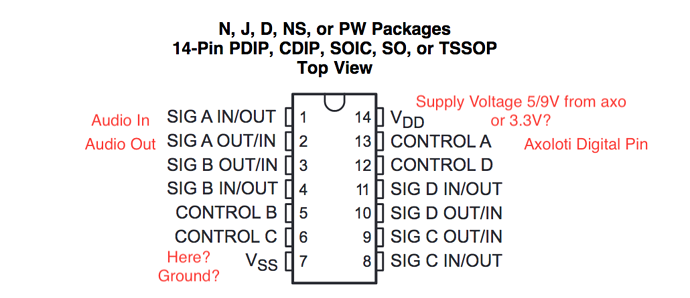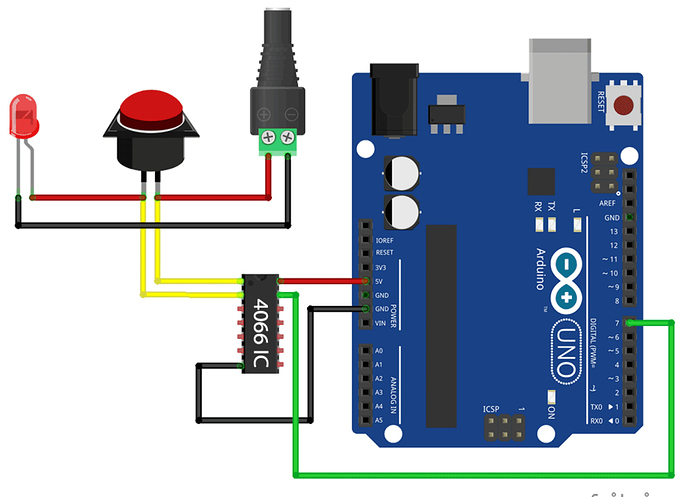VACTROLS, VACTROLS, VACTROLS.....
Have been learning about them today, don't see why they can't solve all the issues and passive at that. And can connect them up to PWM signal, filtered to a regular signal as voltage control for the vactrol, done, problem solved, wallah, bobs your uncle, not mine..
Control volume, cross fade signals, even substitute pots in pedals..
Exactly what I need... I hope... !!
Now just need to find the right parts to buy in bulk..
Digipots and guitar pedals
Hi all,
As promised, here are some sound clips of weird things that I was able to do with a digipot that I liked. These are not attempts to use a digipot for presets or to control commercial pedals. I have a modified clone of a Lovetone Big Cheese that I made and I set it up specifically for this purpose, putting in a switching jack that I can use to swap a digipot in for the fuzz control. So far this is the only pedal I have tried this with (but I have some others waiting ...)
I ended up discovering two things that I found musically interesting:
1) modulating the fuzz tone with weird patterns to create an unusual rhythmic shift (which, given this pedal, also seems to create some sound that is reminiscent of some large beam of wood creaking... I have no idea what that is from, but I like it). A demo of this effect is in this little sound clip:
In the clip, which is extracted from a full song, I am playing rapid chords at first and then I just let the guitar/pedal ring out and feed back.
2) modulating the fuzz "knob" at audio frequencies seems to send this circuit into oscillation in ways I do not totally understand. In this little clip (which was recorded straight with my laptop, so the audio quality is especially poor), I am first just letting the pedal do its thing, and then I layer some guitar stuff over it.
In both cases, I am using a Teensy to control the digipot. In the first case, the pattern is a partial sine-wave sweep with some glitches (zeroed-out spots) in a particular sequence. In the second case, it is a sine wave with a steadily progressing frequency. I have no idea why the pedal clearly jumps from one note to the next in the 2nd case... I expected it to be a straight tone sweep, so something is clearly going on that I don't understand (but I like it).
So anyway, the lesson here is that digipots may not solve all your conundrums in building the perfect guitar system, but you might discover some weird things if you hack a pedal to use one and play around with it.
Sounds promising! Can you post a link of wich vactrol you've been using? Or have you built it yourself?
@kat
that is some pretty rough but nice sounds!
Still doing a few other things first before I dive in the deep end, but I have started tinkering,, they are far too expensive to buy, so yes its DIY Vactrols.
Because I intend to build quite a few, I have ordered 50 LED's, 50 LDR's, next was to find an acceptable build, I have gone with and led with end sanded flat, glued to an LDR with a tiny bit of clear silicon, then into clear heat shrink, then positioned into black plastic tube (outer casing of a cable) just big enough to fit, then both ends sealed with molten black wax. No testing done yet.
Plan is as follows.. Axo will send midi data to an arduino nano, which will interpret and send instructions via I2C to a PWM module, the PWM will then be filtered into a voltage, then connected to the LED of the vactrol. I ma waiting for the PWM module to arrive, as well as a simple midi shield for the nano.
The following are the challenges of concern.. 1 being of most concern.
1. The PWM to voltage filter, there are so many online, many will need to be tested to find out which is the best.
2. Vactrol as voltage divider, getting the correct circuit for this is essential to control the Audio.
3. Vactrol as adjustable resister, this is straight forward but as it is likely to be used to replace pots in an effect pedal, I am thinking of easy way to just unplug a pot and plug in the vactrol.
The reason why I chose this over digipots, cheaper, and it seams a lot easier to do large volumes. The PWM module will have 16 PWM outs, and as many as 96 pwm modules can be connected together, but I won't need that much.
I will start slowly, first with just on / off type control, then adding in parameter like control.
A lot of work to get through..

He @Gavin how is it going with the vactrols?
I've been trying to use the 4066 for switching between different preamp channels but I don't get it to work with axoloti.
Is this right?
EDIT:
Just found this, so my logic seems to be right. I tried VDD both with a 9v battery and 3.3VDD and it didnt work

I tried the 4066, couldn't get it to work either, its my understanding is if you are routing audio through it, VDD to VSS has to cover your full peak to peak swing. So in the case of the Axo, minimum - vdd = +1.65, vss = -1.65. But I never got that far.
As for the vactorals, I still feel as though its the best approach, plenty to test with, I drew up a basic circuit, and even taught myself to etch a circuit board to mount it all on, hack out an old overdrive pedal to test it with, but didn't work, I think I expected better results with less testing, so I need to do more breadboard testing. Its not high priority, but I do slowly chip away at it.
The approach is to have two vactorals operating like a pot, using PWM for switching, so one is controlled by NPN trany and the other by a sister PNP trany. That way they should function opposite to each other, like the turning of the pot.

So that means you would need to a bipolar voltage for fo vdd vss?
It should be possible to get that from the 3.3V of axo right?
I Heard that VDD should be the same voltage as the switching voltage.
Ah that is clever. Yes a pot is indeed two resistors when you turn it so when the one goes up the other goes down.
I'm really interested in this option too. I initially wanted to switch channels on a preamp, to switch between clean, crunch and drive, but I could also just replace the gain and volume by this vactrol system you describe and then just switch between different settings of the two.
Or I give the digipots a try, since Kat already got them to work succesfully 
The reason why I chose not to go with the digipot solution which could still eventuate if this doesn't work, is I was looking into something that way down the track on a larger scale. Not just a way of controlling guitar pedals, but also a matrix mixer type setup per pedal.
So to begin with, for each pedal, 2 buffered signals split and controlled by the vactrol pairs, one to the pedal, one bypassing the pedal, then at least 4 more vactrol pairs retro fitted in place of the pedal pots, this would chain about 5 pedals, all routed via matrix mixer for 5 pedals would require at least 15 more vactrol pairs to assemble.
I know I am way ahead of myself on this, but who knows how far I will get..
Regarding the 4066.. to get bipolar voltage from the 3.3volts on the Axo, you will need to create a virtual ground. I don't have a lot of experience in this area, but check online, there are lots.
That sounds very ambitious! Could be a great system in the end though!
So you will use pwm in order to control the vactrols right? How do you get that many outputs?
For matrix like aplications I'm very happy with my fireface ucx, I figured out how to controll it via midi in standalone from axoloti so I will use it to mix different instruments and then send them to multiple axolotis either as send fx, routing through the axo, or for sending channels to a looper.
The big advantage of this is that it's mainly an audio interface so I can record all the layers seperetaley.
And I get eq+compressor per channel.
In your use case it might be too much ad/da conversions though maybe.
I've been trying to built a mixer with opamps, there is plenty of examples that require virtual ground, but somehow I never got that to work properly.
I've made good experience with these kind of boards for powering a rolang gk preamp with +-9v from axo 5V
Ambitious Yes, expect to achieve highly unlikely but who cares, I am giving myself alot of time to chip away at it, not too fused if I don't get their, but it will be cool to learn about it along the way.
Yes, vactorals are controlled with PWM.
Pedal Side..
For outputs, what I see is, you have your base signal per per pedal, split the signal into two with a buffer splitter, control both levels with Vactrols, one signal goes to the pedal, the other signal bypasses the pedal, and then both signals are mixed back togethether befor the next pedal.
Matrix side.. (not like to matrix's I have seen on line)
For each chanel of the matrix mixer, there is cascading buffer splitter,in the case of 5 pedals, 5 buffers, first split to 5 out puts, next 4 and so on. I have found with this setup, pedals can be sequenced in series and or parallel as prefered, but unlike the matrix mixers I have seen on line, you can't feedback onto a pedal already being used in an earlier sequence. Vactrols will be at each buffer output to be able to select the desiredpedal sequence.
The reason for all this is because I think current pedal loopers are severely overpriced and very limited with what they can do, and in additionj with this setup, adding the vactrols allows it to be controlled by midi. And I have also seen realy awkward attempts to retro fit midi systems to guitar pedals, and convinced there has to be an easier way. On paper, the idea is cool, and happy to share as may be someone esle may get enspired and be better at doing it.



